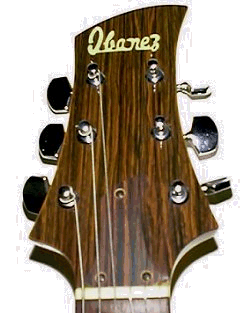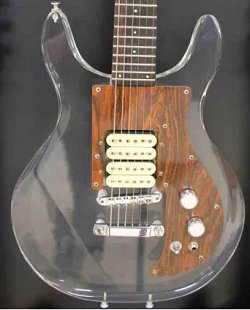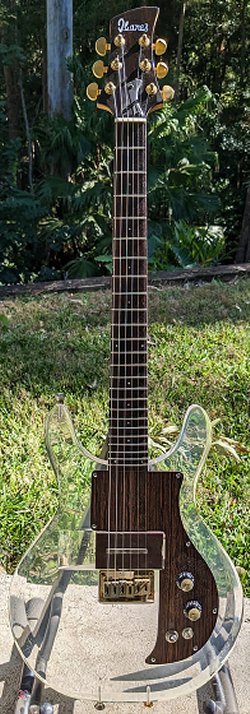
Ibanez
entered the fray with their version of the Dan Armstrong · Ampeg guitar.
Known as guitar model 2364 it sports the ubiquitous wrap-around type scratchplate that's often seen on many of the other copy badge names. Photos courtesy of
Robert Larson (left) and Randall Crocker (right).
Not surprisingly, the similarities don't end there. Like the other badged named copies, this model features two twin humbucking type pickups a tuno-matic style bridge
and stop style tailpiece in the usual Gibson fashion.
At left & right and of interest to me is that the tuno-matic styled bridge has nylon saddle pieces and there appears to be no lack of opinions on which is better,
nylon or steel saddles. Supporters of steel state that nylon is 'way too fuzzy', indistinct and lacking 'sting'. Whereas steel saddles 'absolutely sings,
have excellent snap, & twang as well as a much deeper, well-defined bass.' Like most everything else, it probably all boils down to user preference.
Another Ibanez 2364 model at left. Notice how this particular instrument has a bridge with metal saddles vs. the nylon saddles
on the models above. This anomaly seems somewhat odd and hard to understand. I can only assume that different vendors supplied
the hardware, or at least the bridges for these instruments.
At right, following the neck up to the headstock one can see the Ibanez name on the headstock.However, when looking over the
1971 Ibanez brochure it comes as no
surprise that neither the guitar nor the bass instrument features a brand name on them. The sporatic use of the name on the headstocks of these instruments is
hard to understand.

|
At left, a closer look at the headstock on this instrument. Using Google's Translator app I was able to decipher the text that accompanied this guitar which
reads as follows:
Ibanez 2364 Plexi Guitar
Year of construction: 70's
Country of origin: Japan
Serial number: n / a
The ad states "As you can see a very good copy of the legendary by Dan Amstrong/Ampeg. In the 70s there were no copyrights or
anything like that in Asia, it was happily copied and sold on it. The only thing that's different about this guitar is the neck (thicker).
The machine heads are potted (Kluson), and the pickups cannot be exchanged. I think I'll change the PU (e.g. Gibson HBs or Bill Lawrence HB),
and maybe swap the machine heads for Schaller, then I'll have a perfect brat guitar that throws out a lot of highs and an unbelievable attack.
|

|
At left, another Ibanez 2364 model, but this one sporting replacement pickups. I can't say for certain, but the pickups look like they
might be DiMarzio Super Distortion Humbuckers which would be somewhat consistant with the time frame that the guitar was made.
|
At upper left, an Ibanez 2364. Seen best in the enlarged view these instruments are much like other copies in that the chrome plated pickups feature a single
coil within. The maple neck with a mahagony center offer a clear view of the hardware within the cavities.
At upper left, the headstock of this model shows the Ibanez name . Also, like most copies the wood pattered veneer reveals blistering. At right,
the usual tuners that accompany most copy instruments of this era can be seen.
At upper left, a clean looking 2364 model but with the 'A' string saddle in the bridge placed way back relative to the others. This could just
be a matter of turning the saddle piece the other way around however. On the right, and not nearly as clean, another 2364 model with issues
around the truss rod cover as well as the output jack.

|
At left, a very unusual Ibanez guitar that's owned by Mike Laberta. This instrument is very much unlike the stock models seen above
as well as within the Ibanez product literature seen at the top of this page.
|
As seen at left & right - one very noticable difference on this instrument is the fact that the acrylic body sports a sweeping scoop in it
to accept interchangable pickups yet product literature does not show, nor state that their model features interchangable pickups - yet here
is a model that does. In addition is a combination string-thru bridge-tailpiece which seems somewhat redundant being Ibanez Dan Armstrong
copies came stock with a stop tailpiece and a tunable bridge.
Seen at left and right, both guitars are the Ibanez 2364 model and it's here where things get both interesting and confusing. Seen better in
the enlarged view, routing can be seen in and around the bridge/tailpiece area. In the enlarged view - you can easily see extra drilled holes
- some being used, and some not. Notice at left, the neck features a much longer neck tongue - like that seen on the original Ampeg guitar
models and very much unlike the stock Ibanez 2364 model.
At right is another Ibanez 2364 guitar model which, like every other model in this line features a neck with a much shorter tongue than the
model on the left, Reason being - the guitar body is routed out for two single-coil pickups which have the same dimensions as standard
humbucking pickups - thus taking up extra space in the body. As a result, the neck tongues on these guitars are much shorter on the Ibanez and
most other copy brands. In fact, the only brands that feature long neck tongues are those with interchangable pickups and the sweeping scoop
in the acrylic body. To date, only the Electra and Ventura brands employ the interchangable pickup design. Yet here is an Ibanez model that
has it when all the other Ibanez guitar models do not.
The question that faces us all is.... how can such a guitar be so far off from factory literature when all other guitars in that line were
made to specs as per their literature? After some discussion with it's owner Mike Laberta, we tend to agree that this instrument is a
'one-off' of sorts - likely produced in a factory that produced various copy brands and where a mistake took place. As such, what started off
as one brand of instrument ended up as a different brand. The only other alternative is that Ibanez re-tooled everything for only one guitar
which seems way too extreme.
At left the headstock from the front features a glossy faux-wood veneer with the Ibanez name in mother-of-pearl. Notice what looks like a
sun-faded truss rod cover. Take note of the smudge in the finish just to the upper left of the top mounting screw of the truss rod cover. At
right, and seen from the back, gold plated Grover Rotomatic's have replaced the original tuners.
At left & right, by the time Mike received the guitar the faux-wood veneer of the headstock had been covered over with a black finish. It's
unknown why, but notice that same smudge mentioned earlier is still visible which seems rather odd. A different truss rod cover that matches
the scratchplate has replaced the one seen earlier. In the enlarged view, it looks like the letters CW are scratched into the finish. Notice
the two bottom screws are missing.
During the 1970's Ibanez guitars were made in Japan, almost exclusively at the Fujigen Gakki manufacturing plant, and were
distributed in the US by Harry Rosenbloom, in Ardmore, Pennsylvania. Today, Ibanez instruments are distributed by Hoshino (U.S.A.) Inc.
1726 Winchester Road Bensalem, PA 19020 which is a subsidiary of the Hoshino Gakki Group.
copies menu
main menu
Names and images are TMand © Dan Armstrong / Ampeg. All rights reserved.
All other names and images are TMand © of their respective owners. All rights reserved.
|
| |

